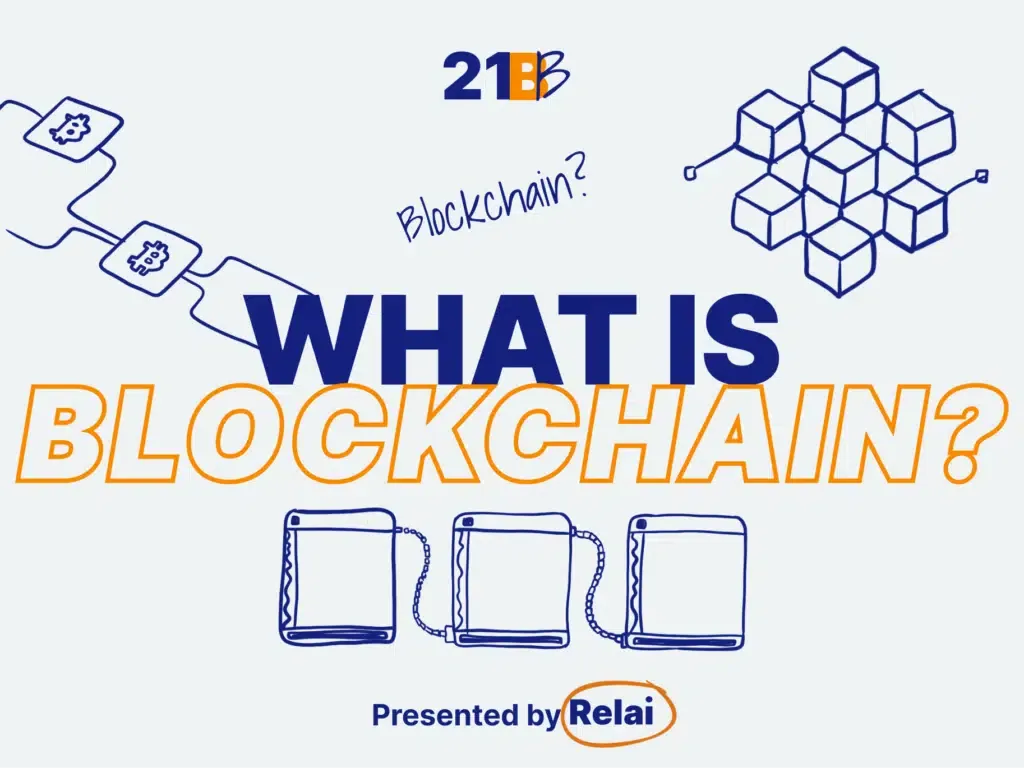But what exactly is blockchain, and how does it work?
Read on to find out.
BLOCKCHAIN EXPLAINED
A blockchain is a digital ledger that is recorded on a distributed network of computers around the globe. Transaction information is stored in blocks that form a chain. Hence, the term “blockchain.”
In simple terms, a blockchain is a distributed database that contains transactional information that cannot be modified after it’s recorded.
In the case of Bitcoin, financial transactions are stored on the Bitcoin blockchain, allowing anyone to publicly view and verify all bitcoin transactions in real-time using a block explorer.
To update the digital ledger, all network participants (nodes) have to agree that all transactions going into a block are correct based on the rules that govern the network.
The Bitcoin network uses a Proof-of-Work (PoW) protocol to verify transactions and achieve distributed consensus, i.e., to make sure everybody agrees on the current state of the blockchain. In the Bitcoin network, so-called “bitcoin miners” are the network participants who process and validate transactions, adding new blocks to the Bitcoin blockchain.
ARE BITCOIN AND BLOCKCHAIN THE SAME?
No. What we call ‘Blockchain’ is just one out of four components that define Bitcoin:
- Scarce (limited to 21 million)
- Decentralized (peer-to-peer instead of a centralized system)
- Proof-of-Work (miners are getting rewarded with new BTC)
- Open Blockchain (code & transactions)
‘Blockchain’, as used by Bitcoin, is essentially a slow and expensive database without the other three components.
IS EVERY BLOCKCHAIN THE SAME?
No. Satoshi Nakamoto mentioned a ‘chain of blocks’ in his original Bitcoin Whitepaper. The buzzword ‘blockchain’ was invented years later when the British magazine ‘The Economist’ ran a cover story in the autumn of 2015 called ‘The trust machine – How the technology behind bitcoin could change the world. It’s a common misconception to refer to the way Bitcoin organizes data as ‘blockchain technology’.
Yes, Bitcoin is the first cryptocurrency that implemented a chain of data secured by cryptography and organized in blocks. But it’s not compatible with the thousands of other cryptocurrencies that followed later. That means: ‘Blockchain technology’ doesn’t exist. There is the Bitcoin blockchains, and there are other blockchains with usually completely different rules.
Open blockchains, such as the Bitcoin blockchain, operate without the involvement or required approval of a central authority, allowing anyone with an Internet connection to participate by running the Bitcoin software.
Blockchains differ from other databases primarily due to their decentralized nature, making it very difficult to alter or tamper with the information recorded in blocks. As a result, blockchain technology has become very popular among enterprises and financial institutions as it can be deployed to create safer and more robust systems.
TRANSACTIONS ON THE BITCOIN BLOCKCHAIN: HERE’S HOW THEY WORK
Sending bitcoin from one wallet to another is pretty simple. What goes on in the background to make that happen, however, is a bit more complex and part of Bitcoin’s brilliance.
Here’s the journey of a bitcoin transaction on the blockchain.
- A user broadcasts a request to send bitcoin.
- The Bitcoin network receives the request for a transaction.
- Nodes authenticate the transaction via the consensus mechanism.
- The relevant transaction data is added to a block.
- The entire block is added to the chain after a threshold of confirmations is achieved.
- The transaction is finished and permanently added to the ledger.
While blockchain may be more difficult to comprehend than Bitcoin itself, the most important thing to understand is that the Bitcoin blockchain is an immutable public ledger that verifies and records all bitcoin transactions.
Takeaways:
- ‘Blockchain’ as used by Bitcoin, is essentially a slow and expensive database. Other components like Bitcoin’s scarcity, decentralized nature, the proof-of-work consensus mechanism, and the openness of its blockchain (both code and transactions) make it unique – and valuable.
- ‘Blockchain technology’ doesn’t exist. There are the Bitcoin blockchains and other blockchains with usually completely different rules.
- The Bitcoin blockchain is an immutable public ledger that verifies and records all bitcoin transactions.
Disclaimer: None of this content constitutes investment advice. Always conduct your own research before investing in any digital asset.

Relai
Europe’s easiest bitcoin investment app. Buy bitcoin in 1 minute or set up an automatic savings plan. Here to spread bitcoin education and make stacking sats easy.
follow me :




Related Posts
How does Bitcoin Mining Work?
Jul 05, 2025
7 Bitcoin Scams You Need To Be Aware Of
Jul 05, 2025
What is Bitcoin?
Jan 16, 2025